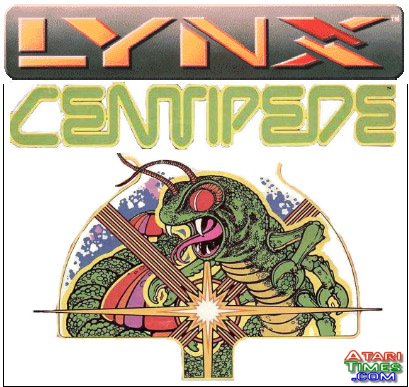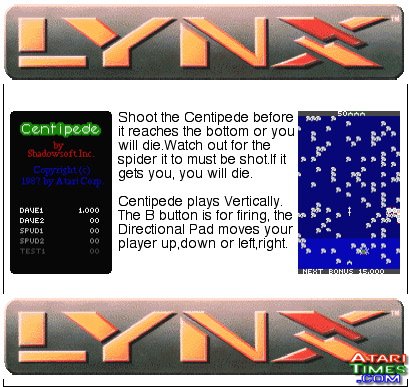 |
 |
Centipede |
Centipede was originally developed by Canadian software house Shadowsoft, who brought to the Lynx such excellent products as Robotron, Joust, and the Songbird-released Lexis. On the basis of their other releases, I'd assume that Shadowsoft intended here to faithfully reproduce another arcade classic; the demo of what we do have sure isn't Centipede 2000. It appears that coding was halted somewhere past the alpha stage due to Atari's faltering support for its handheld system; Centipede was ultimately canned and never finished. Lance Ringquist advises that he found his copy of Centipede on an old TT hard drive from Atari's Lombard, Illinois site, and other copies are known to exist from other sources. It's possible that the version released simultaneously from B&C Computervisions uses alternate source code, and some minor variations may exist in the carts now available from the two companies.
The original arcade concept of Centipede was a wonderful evolution of Space Invaders and was enormously popular in the arcades and on game consoles from the early- to mid- 1980s. It was also, significantly, the first video game that attracted large numbers of female game players -- ostensibly due to the bug-squashing plot of the game. Sociological explanations aside, Centipede found fans for its revolutionary introduction of the trackball controller, expanded field of play (which liberated players from the lowest playing position, as in Space Invaders) and user-friendliness. Lynx players have to make do with the joypad in lieu of the trackball, but thankfully most of the other elements of the original have been retained.
The centipede still makes its journey from the top left-hand corner of the screen to the bottom right corner, and good use is made of the Lynx's vertical orientation to replicate the approximate environment of the original arcade game. The playing field is actually larger than the actual size of the Lynx screen, and players can scroll to the expanded field by moving their ship to the far right of the screen and continuing beyond the screen's border. The path of the centipede's journey is predicated on the placement of mushrooms; the centipede will always change direction when it encounters a mushroom in its path.
As in all versions of the game, centipede pieces are turned into mushrooms when shot by the player. Mushroom elimination seems to require an extremely high number of shots; the ship only fires two shots at a time, and players may well be frustrated by the effort required to clear a substantial area of the playing field.
The only gaming hazard present in the game aside from the centipede itself is the spider; neither the mushroom-dropping "flea" nor the scorpion is, sadly, to be found in the Lynx version. The spider is, however, ever-present here, and provides, depending on your perspective, either a constant gaming irritant or bonus hazard in the game.
Some players have suggested that a "sweet spot" exists on the screen in which players can take refuge from the spider and blast away; this may be true, but I haven't found it yet. Gamers can briefly enjoy the results of good games on a high score screen; these cannot, however, be saved.
Centipede on the Lynx is not an easy game, and players do not have the option of selecting levels at the title screen. Centipede seems to begin at an "intermediate" level of play, and the game quickly progresses upwards through difficulty levels that will challenge even expert game players.
Centipede certainly doesn't push the Lynx's graphics envelope, but all game pieces are clearly detailed and easily recognizable. You can, in other words, distinguish a mushroom from the spider or the centipede itself, and this is a very good thing indeed given the game's frantic pace. The game's colour palette is primarily limited to a patriotic red, white, and blue, though there are splashes of other colours throughout.
Simply put, there isn't any. This is by far the greatest weakness in the Lynx version, and it detracts significantly from game play. It's arguable that the arcade version of Centipede was the first game that utilized game sound and sound effects as more than ambient background noise; crucial early warning of impending danger was provided by a sound unique to each game hazard. Because the Lynx version has no sound, it is impossible to determine when the spider is about to approach. Players should therefore expect to lose at least one ship per round due to unwelcome arachnid intrusions. It's certainly a pity that no sounds were coded at all, and Lynx gamers will have to rely on their imaginations to add some aural excitement to their games.
Centipede, as released, plays a fair game, and gaming fanatics probably won't be too disappointed either by the lack of in-game sound, comparatively high difficulty, and graphical simplicity of the game. The demo version of Centipede that has been released hints that, like Shadowsoft's other products, the final version of this game would have made an outstanding addition to the Lynx library. While Lynx gamers probably will never get to see a finished, polished product on their screens, they can be grateful indeed that this piece of gaming history has been preserved and, more importantly, released to the general public.
Video 61 sells Centipede for $49.95, a price that includes shipping. My game arrived quickly from Minnesota with attractive "retro" packaging that you'll definitely want to retain as an integral part of your game. It can be difficult to dislodge the thick green EPROM from the Lynx unit, but you probably won't destroy either console or cart in the process.
Lance Rinquist has slyly hinted that Centipede is just the first of several Lynx surprises that he found stashed away on that hard drive. If that is true, 2003, which marks the tenth anniversary of the commercial death of the Lynx, actually promises something of a revival.
Now if only Lance can find a working version of Mechtiles...


| Name: | |
| Subject: | |
| Comment: | |
| Check: | What is the greatest video game company of all time? (Hint: Atari.) |